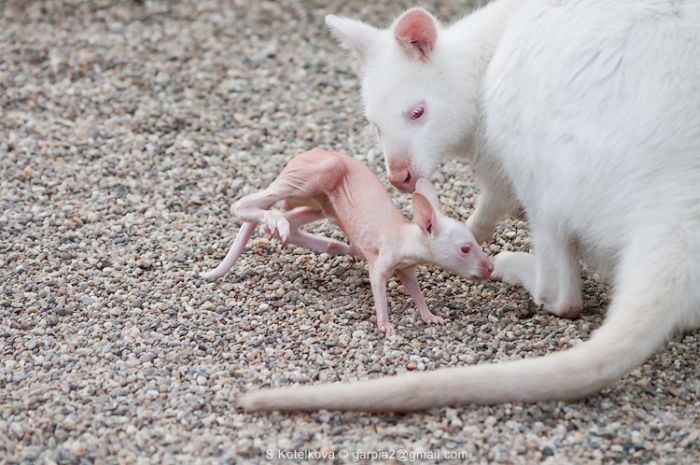|
|
Mother And Baby White Kangaroo
|
Groups of kangaroos are called mobs. Mobs usually have 10 or more kangaroos in them. Living in mobs provides protection for some of the weaker members of the group. The size and stability of the mobs vary between geographic regions, with eastern Australia having larger and more stable aggregations than in arid areas farther west. Larger aggregations display high amounts of interactions and complex social structures, comparable to that of ungulates. One common behaviour is nose touching and sniffing, which mostly occurs when an individual joins a group. The kangaroos performing the sniffing gain much information from smell cues. This behaviour enforces social cohesion without consequent aggression. During mutual sniffing, if one kangaroo is smaller, it will hold its body closer to the ground and its head will quiver; this is possibly a form of submission. Greetings between males and females are common, with larger males being the most involved in meeting females. Most other non-antagonistic behaviour occurs between mothers and their young. Mother and young reinforce their bond though grooming. A mother will groom her young during or after it is suckling. A joey will nuzzle its mother’s pouch if it wants access to it.
Sexual activity of kangaroos consists of consort pairs. Oestrous females roam widely and attract the attention of males with conspicuous signals. A male will monitor a female and follow her every movement. He sniffs her urine to see if she is in oestrus, a process exhibiting the flehmen response. The male will then proceed to approach her slowly to avoid alarming her. If the female does not run away, the male will continue by licking, pawing, and scratching her, and copulation will follow. After copulation is over, the male will move on to another female. Consort pairing may take several days and the copulation is also long. Thus, a consort pair is likely to attract the attention of a rival male. As larger males are in tending bonds with females near oestrus, smaller males will tend to females that are farther from oestrus. Dominant males can avoid having to sort through females to determine their reproductive status by searching for tending bonds held by the largest male they can displace without a fight.
Fighting has been described in all species of kangaroos. Fights between kangaroos can be brief or long and ritualised. In highly competitive situations such as males fighting for access to oestrous females or at limited drinking spots, the fights are brief. Both sexes will fight for drinking spots, but long, ritualised fighting or "boxing" is largely done by males. Smaller males fight more often near females in oestrus, while the large males in consorts do not seem to get involved. Ritualised fights can arise suddenly when males are grazing together. However, most fights are preceded by two males scratching and grooming each other. One or both of them will adopt a high standing posture, with one male issuing a challenge by grasping the other male’s neck with its forepaw. Sometimes, the challenge will be declined. Large males often reject challenges by smaller males. During fighting, the combatants adopt a high standing posture and paw at each other's heads, shoulders and chests. They will also lock forearms and wrestle and push each other as well as balance on their tails to kick each other in the abdomens.
Brief fights are similar except there is no forearm locking. The losing combatant seems to use kicking more often, perhaps to parry the thrusts of the eventual winner. Winners are decided when a kangaroo breaks off the fight and retreats. Winners are able to push their opponents backwards or down to the ground. They also seem to grasp their opponents when they break contact and push them away. The initiators of the fights are usually the winners. These fights may serve to establish dominance hierarchies among males, as winners of fights have been seen to displace their opponent from resting sites later in the day. Dominant males may also pull grass to intimidate subordinates.
|
|









